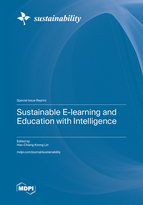Sustainable E-learning and Education with Intelligence
A special issue of Sustainability (ISSN 2071-1050). This special issue belongs to the section "Sustainable Education and Approaches".
Deadline for manuscript submissions: closed (12 August 2023) | Viewed by 32880
Special Issue Editor
Interests: affective computing; artificial intelligence; digital learning; educational technology; metaverse; digital arts
Special Issues, Collections and Topics in MDPI journals
Special Issue Information
Dear Colleagues,
Education provides the best channel of inheritance for mankind's sustainable cultivation of talents. In recent years, there have been many researches on educational technology. Coupled with the COVID-19 period, distance learning and e-Learning have become important trends, and various platforms, applications, autonomous learning, and guidance strategies have all become important topics. In addition, the application of artificial intelligence in education and learning has also received a lot of research manpower input, with the purpose of applying smart technology to improve learning effectiveness. Therefore, this Special Issues will be discussed in the following topics (not limited), and contributions are welcome:
- E-Learning
- Education Technology
- Human Resources and Training
- Distance Learning
- Artificial Intelligence
- AI in Education
- Intelligence Tutoring System
- Affective Computing and Analysis
- Emotions in Learning
- Self-paced Learning (Self-regulated and Self-directed Learning)
Prof. Hao-Chiang Koong Lin
Guest Editor
Manuscript Submission Information
Manuscripts should be submitted online at www.mdpi.com by registering and logging in to this website. Once you are registered, click here to go to the submission form. Manuscripts can be submitted until the deadline. All submissions that pass pre-check are peer-reviewed. Accepted papers will be published continuously in the journal (as soon as accepted) and will be listed together on the special issue website. Research articles, review articles as well as short communications are invited. For planned papers, a title and short abstract (about 100 words) can be sent to the Editorial Office for announcement on this website.
Submitted manuscripts should not have been published previously, nor be under consideration for publication elsewhere (except conference proceedings papers). All manuscripts are thoroughly refereed through a single-blind peer-review process. A guide for authors and other relevant information for submission of manuscripts is available on the Instructions for Authors page. Sustainability is an international peer-reviewed open access semimonthly journal published by MDPI.
Please visit the Instructions for Authors page before submitting a manuscript. The Article Processing Charge (APC) for publication in this open access journal is 2400 CHF (Swiss Francs). Submitted papers should be well formatted and use good English. Authors may use MDPI's English editing service prior to publication or during author revisions.
Keywords
- E-Learning
- education technology
- human resources and training
- distance learning
- Artificial Intelligence
- AI in education
- intelligence tutoring system
- affective computing and analysis
- emotions in learning
- self-paced learning (self-regulated and self-directed learning)






